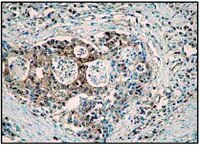Lovastatin-induced apoptosis is modulated by geranylgeraniol in a neuroblastoma cell line.
Annalisa Marcuzzi,Valentina Zanin,Elisa Piscianz,Paola Maura Tricarico,Josef Vuch,Martina Girardelli,Lorenzo Monasta,Anna Monica Bianco,Sergio Crovella
International journal of developmental neuroscience : the official journal of the International Society for Developmental Neuroscience
30
2011
Mostrar resumen
Mevalonic aciduria (MA), the most severe form of mevalonate kinase deficiency (MKD), is still an orphan drug disease and the pathogenetic mechanisms underlying neuronal dysfunction is still poorly understood. In our study we have investigated the apoptotic mechanism mediated by the exposure of the cultured neuroblastoma cell line, SH-SY5Y, to lovastatin in absence or in presence of the isoprenoid, geranylgeraniol, with the aim of unraveling the pathogenesis of MA. Lovastatin, blocks the mevalonate pathway inhibiting the 3-hydroxy-3-methylglutaryl-CoA reductase (HMG-CR), an enzyme of the mevalonate pathway upstream the mevalonate kinase enzyme, reproducing biochemical features similar to those found in MKD. We demonstrate that apoptosis in neuronal lovastatin treated-cells is induced by the mitochondrial pathway, with caspase-9 as the initiator and caspase-3 as the effector caspase. The presence of geranylgeraniol modulates both the caspase-9 and caspase-3 activity in a dose-dependent way, confirming that this isoprenoid enters the mevalonate pathway, is metabolized and finally is able to by-pass the statin biochemical block reconstituting the mevalonate pathway. According to our findings, it should not be the time course adopted that modulates the apoptotic response but rather the isoprenoid itself. Being aware that our results have been obtained using a biochemical model of MKD, and not cells from patients with the disease, we believe our findings increase the knowledge of MA pathogenesis, and may possibly contribute to the development of novel therapeutic strategies. | 22759742
 |
Inhibition of NF-kappaB activation reduces the tissue effects of transgenic IL-13.
Svetlana P Chapoval,Amal Al-Garawi,Jose M Lora,Ian Strickland,Bing Ma,Patty J Lee,Robert J Homer,Sankar Ghosh,Anthony J Coyle,Jack A Elias
Journal of immunology (Baltimore, Md. : 1950)
179
2007
Mostrar resumen
IL-13 is a major Th2 cytokine that is capable of inducing inflammation, excessive mucus production, airway hyperresponsiveness, alveolar remodeling, and fibrosis in the murine lung. Although IL-13 through its binding to IL-4Ralpha/IL-13Ralpha1 uses the canonical STAT6-signaling pathway to mediate these tissue responses, recent studies have demonstrated that other signaling pathways may also be involved. Previous studies from our laboratory demonstrated that IL-13 mediates its tissue effects by inducing a wide variety of downstream genes many of which are known to be regulated by NF-kappaB. As a result, we hypothesized that NF-kappaB activation plays a critical role in the pathogenesis of IL-13-induced tissue alterations. To test this hypothesis, we compared the effects of transgenic IL-13 in mice with normal and diminished levels of NF-kappaB activity. Three pharmacologic approaches were used to inhibit NF-kappaB including 1) PS1145, a small molecule inhibitor of IkappaBalpha kinase (IKK2), 2) antennapedia-linked NF-kappaB essential modulator-binding domain (NBD) peptide (wild-type NBD), and 3) an adenoviral construct expressing a dominant-negative version of IKK2. We also crossed IL-13-transgenic mice with mice with null mutations of p50 to generate mice that overproduced IL-13 in the presence and absence of this NF-kappaB component. These studies demonstrate that all these interventions reduced IL-13-induced tissue inflammation, fibrosis and alveolar remodeling. In addition, we show that both PS1145 and wild-type NBD inhibit lung inflammatory and structural cell apoptosis. PS1145 inhibits caspase activation and up-regulates inhibitor of apoptosis protein cellular-inhibitor of apoptosis protein 1 (c-IAP-1). Therefore, NF-kappaB is an attractive target for immunotherapy of IL-13-mediated diseases. | 17982094
 |













--Camphor-10-sulf_acid[840094_(1R)--Camphor-10-sulf_acid-ALL].jpg)
